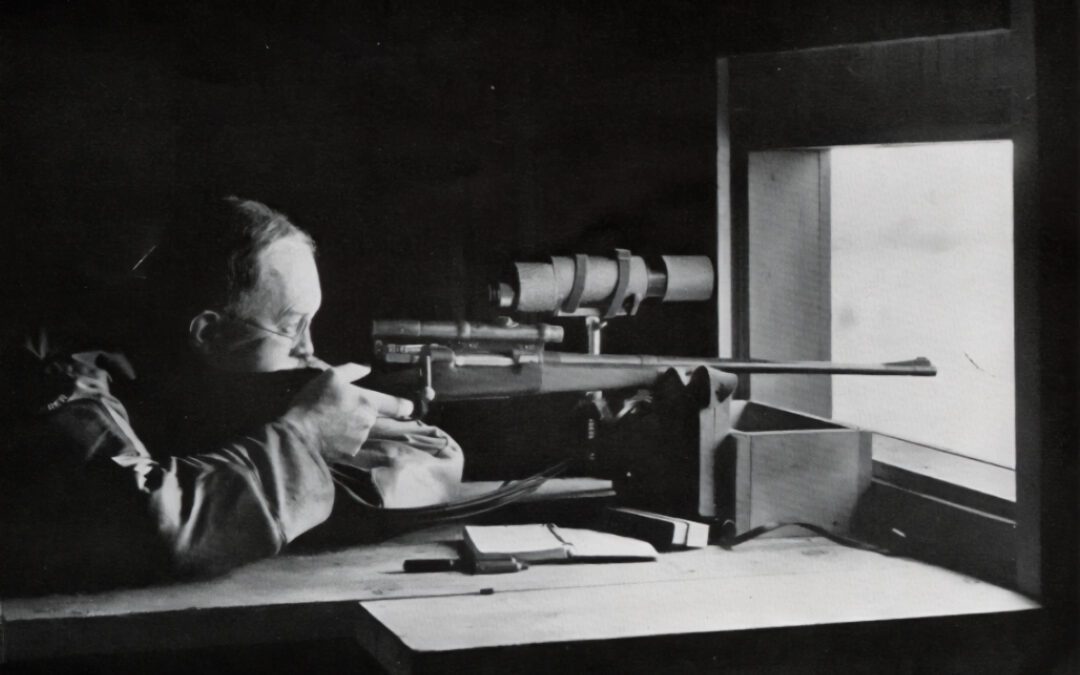It arrived in a small box not on its first trip. The return address, hand-scrawled, was unfamiliar. I slit the tape. Inside, a nest of paper held an old hunting knife, a fixed-blade Marble’s of the type popular in deer camps when I was young. It had been well used, carefully honed. Tucked inside its heavy leather sheath was a folded note. It drew me back a century.
At that time, overland travelers to the Yukon and other points north rode Canadian Pacific rails to Ashcroft, British Columbia, southern terminus of the Telegraph Trail. From there, country slid by slowly beside the saddle. An unlikely passenger in mid-summer 1901 was a young man awaiting his chance at a commission in the U.S. Army. He had resigned his post in the Pennsylvania National Guard for a “final fling at wilderness life.” Arriving in Ashcroft with two Winchester rifles, an 8×11 tarp sewn from Army blankets, a set of camp kettles and untested optimism, he set about outfitting himself for the adventure. “I bought a saddle horse for $25, two pack horses for $15 each, a stock saddle for $25, two sawbuck saddles for $5, and $25 worth of grub. An old prospector showed me how to pack the horses and throw a diamond hitch.” The next morning he started up the Trail alone.
A couple of days on, he met an Indian boy, then lodged with him that night. The following day he rode into the frontier mining town of Lillooet, unsaddling in the corral by the Victoria Hotel. Drinks there cost two bits. He didn’t know what two bits was. The next morning, he chanced upon Bones Andrews, a “buckskin-clad hunter and prospector” with a couple of seasoned horses.
The New England youth had little in common with Bones. But the two got on well and agreed to travel together. They would split expenses and all proceeds from the trip. A Free Miners Certificate would permit them to kill game as needed for food. Bones advised his companion to buy “three pairs of Indian-made buckskin moccasins, half a buckskin for resoling them and two pieces of canvas for pack covers.”
None of Townsend Whelen’s ancestors were noted for wilderness adventures – though survival in the outdoors may well have figured into their experiences in the New World. James Stephenson Whelen, of English, Scotch and Irish descent, came to the continent in 1692. A Quaker, he traveled west to settle in Pennsylvania. Evidently the Whelen clan prospered there, and at least some married locally. Townsend was born March 6, 1877, into a socially upscale Philadelphia family. His mother’s ancestors had also done well for themselves. Whelen would declare, with thinly veiled vanity: “The men of these families have all been bankers, lawyers, college presidents, ministers and doctors.”
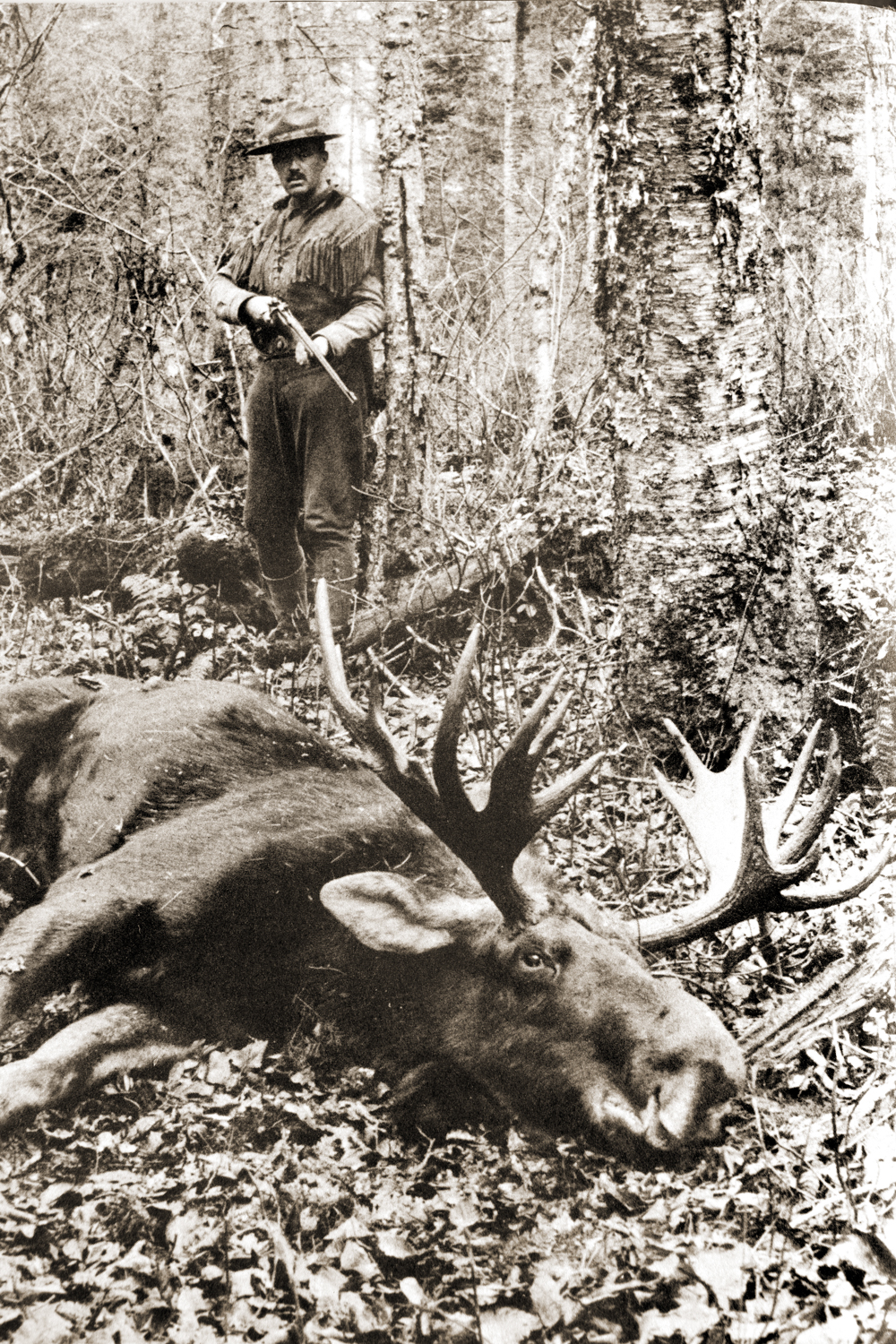
Whelen, here with a moose, favored hunting garb that reflected his military and pioneering interests.
Like Theodore Roosevelt, 19 years his senior, young Whelen was late to the frontier beyond the Mississippi. More than a place, the West was then an event, an historic cyclone re-making landscapes and peoples. Even dull minds spared the preaching of “manifest destiny” pegged its demise within years, not decades. Market hunters were shredding the great buffalo herds, a slaughter that would yield three million tons of bones to human scavengers. Rails joined in ’69 at Promontory Point bore passengers who fired at the shaggy survivors in passing. A tide of damaged men with no moral compass left the wreckage of war for a lawless frontier. Remorseless killers ranged both sides of the badge.
The year before Whelen’s birth presaged the end of that era. The 7th Cavalry lost George Custer and five of its 12 companies to a hurricane of Lakota, Arapahoe and Northern Cheyenne warriors in the Battle of Greasy Grass, on a ridge above the last great gathering of plains tribes. In Deadwood, Dakota Territory, feared lawman James Butler “Wild Bill” Hickok slumped over a card table, dead from the .45 bullet Jack McCall fired into the back of his skull. In Northfield, Minnesota, the James-Younger gang was minced by citizen gunfire, losing three of its eight members after a botched attempt to rob First National Bank. And 17-year-old Billy the Kid, born Henry McCarty in an Irish slum in New York, escaped from a New Mexico jail to Arizona, having taken a predator’s path by robbing a Chinese laundry.
The Philadelphia centennial of 1876 marked the beginning of the end of the frontier West. Within five years, Billy would be dead, remnant knots of buffalo so small and scattered that hunts were pointless. Tribes dependant on the beasts would collapse under the Army’s heavy hand.
Denied the trials and excitement of the West, Townsend Whelen chafed under the privilege that promised so much and made his life so comfortable. Like Roosevelt, he craved the adventure that seemed to beckon just over the horizon.
“As a young boy, I wanted above all else to be a hunter,” he wrote later. The gift of a Remington .22 rifle started him down that path at age 13. He was quick to add a Lyman tang sight. A book on sports, published by the New York Tribune, schooled him on shooting technique. Within a couple of years, he had won a rifle match. That fall he went hunting. From the belly of a canoe, resting his .22 on its gunwale, he shot a deer behind the ear. While his father worked as a physician at a hotel in the Adirondacks, Townsend, or “Townie” as he would be called, hunted small game, learning about the woodlands and their creatures, then offering his services as “an amateur guide at half price.”
Whelen’s other passion was soldiering. His family history included only a footnote on military service, but it was memorable. During the American Revolution, his great grandfather, the Quaker Israel Whelen, had joined General Washington’s staff and became Commissary General of the Army. Later he outfitted the Corps of Discovery under Lewis and Clark, mainly from Frankford Arsenal in Philadelphia. Eager to don a uniform and deploy as an officer, young Whelen prepared to that end, studying the “Manual of Arms” of a friend in military school. An 1895 exhibition by body-builder Eugene Sandow inspired him to whip his “exceedingly weak physique” into better shape. Coached in the use of weights, he gained 30 pounds of muscle and added 7 inches to his chest. At 19 he enlisted in the Pennsylvania National Guard. A sergeant in three years, he was promoted to regimental sergeant-major early in the Spanish-American War. Soon thereafter he was commissioned a second lieutenant.
Whelen’s Guard unit saw no action in Cuba; however, the prospect of soldiering didn’t lose its shine. Waiting impatiently for the chance to earn an Army commission, he studied ballistics and began to write about marksmanship. Neither effort satisfied his craving to explore and hunt in wild places….
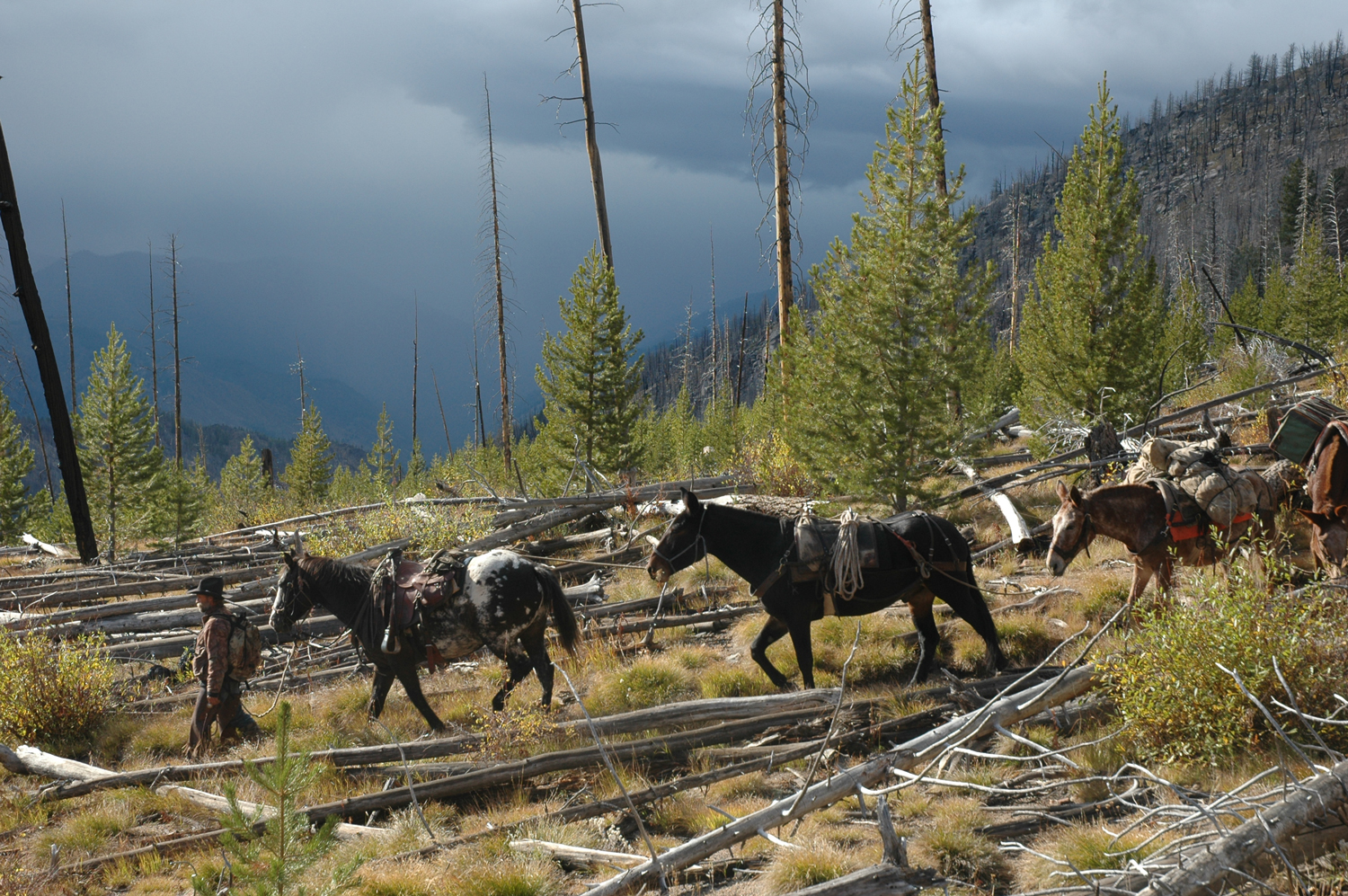
In 1901, a young Whelen bought a horse in B.C. and started up the Telegraph Trail alone. Hunters now hire established outfitters! (Here: Idaho’s Frank Church Wilderness).
Following the Fraser River north on the Telegraph Trail, Whelen and Bones turned up the Bridge tributary. Whelen’s two lever-action Winchesters, a Model 1894 in 30-30 and an 1895 in 40-72, hung from the saddle’s pommel and cantle, without scabbards, almost level on either side. The country’s first smokeless hunting round, the 30-30, was in its sixth year. Whelen had heard “that it killed [like] the 45-70 and 45-90.” Factory loads sent 160-grain bullets at a claimed 1,960 fps with little recoil. The Model 1894 was also lighter than earlier lever rifles. “So when I planned to go West, I got one [then] fitted it with a No. 1 Lyman rear sight on the tang and a Lyman ivory bead front sight.” Keen to rely on this rifle for “living off the land,” he brought 125-grain lead-bullet loads in addition to jacketed soft-points.
One day, riding ahead of the pack string, Whelen came upon a grizzly just a few yards away. He jumped off his horse, grabbed the 30-30 and loosed three bullets. Alarmingly, “the bear showed no sign of being hit.” Obligingly, it wandered off. About then Whelen recalled having charged the magazine with small-game loads, a mistake he sheepishly reminded himself not to repeat.
The 30-30 would perform well on that trip, taking most of Whelen’s game. He allowed he “could not hit reliably with it beyond [roughly] 200 yards. Even so, that was 50 yards farther than I was sure of hitting with my 40-72.” A modern 30-30 load, he would conclude, was adequate for “all American big game” to 150 yards, albeit a “heavier cartridge [with] a long, heavy bullet” was better for elk and moose. That 1894 Winchester would serve him five more years, killing “many mule deer and one large goat.”
Months into British Columbia, after more hunting than the Adirondacks would have delivered in decades, Whelen bid Bones farewell at Big Bag Creek and made his way east to the Telegraph Trail. He joined there a pack string bringing gold and furs from the Quesnel country to Ashcroft. “Two groundhog robes [we bought] from a bunch of Chilcotin Indians we met on the trail” would fetch large sums in New York and put the net cost of his Canadian adventure at about $100. Beyond accounting, though, it proved an invaluable experience that would stay sharp in memory and profit Whelen’s career. “I had a wonderful time [and learned] how to rustle for myself,” he wrote. He would ever find comfort under a lean-to, eating simple trail food. In the vastness shadowed by the northern Rockies, he became a man.
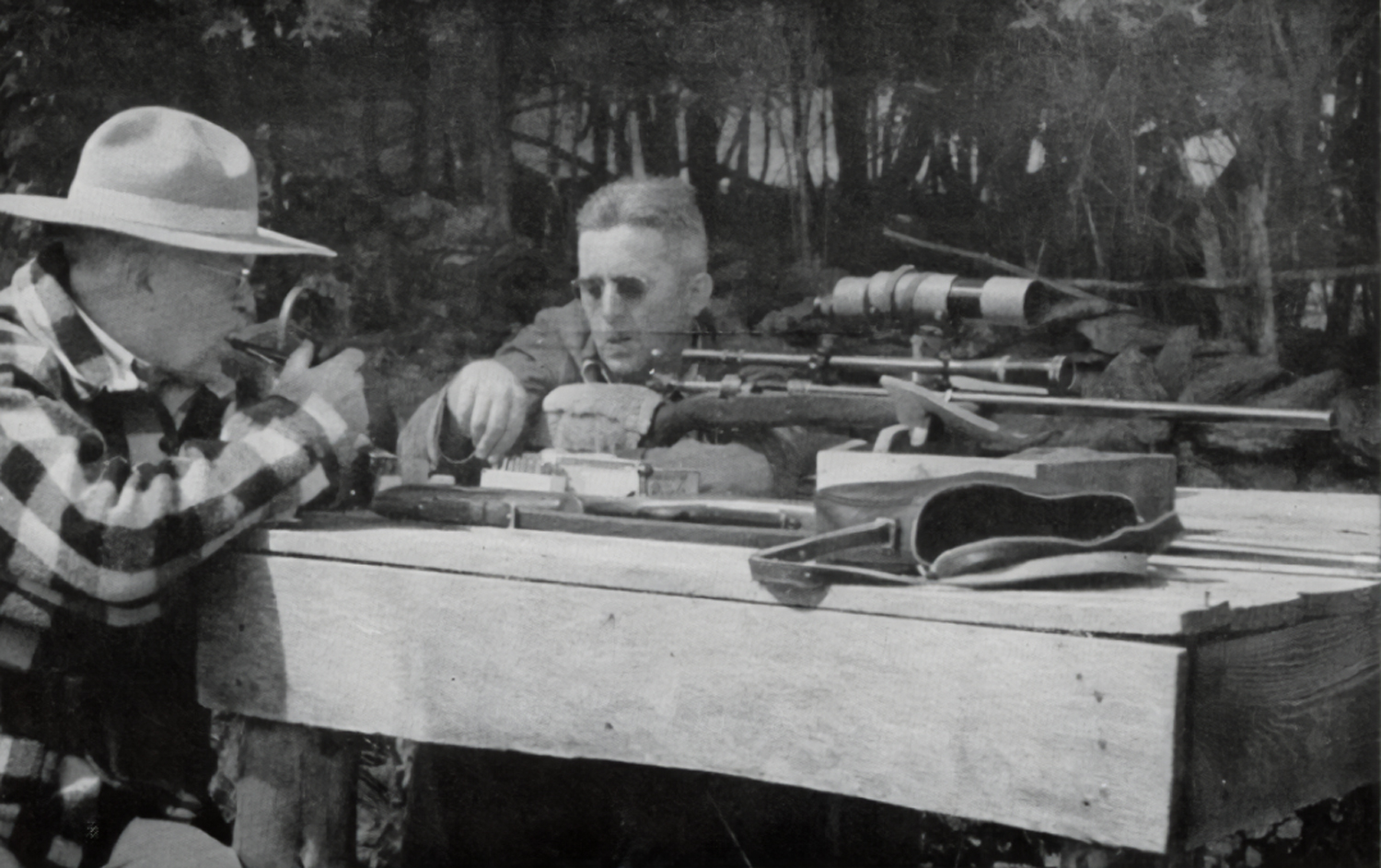
Colonel Whelen and J. Bushnell Smith conducting a simple ballistic experiment on the rifle range.
By May, 1902, Whelen had learned 50 applicants would be chosen to take the Army’s entrance exam. His father knew important people in Washington, and promptly used that network to get Townsend an interview with the president. Impressed by the strapping 25-year-old in his office, Roosevelt no doubt would have warmed to Whelen’s wilderness travels—similar to his own adventuring in Dakota Territory 20 years earlier. There’s no record of such an exchange. Whelen recalled Roosevelt took a quick measure and said, “You are the type of young man I want to see in the Army.” Then he directed Secretary of War Elihu Root to give him the exam.
“It was as simple as that,” shrugged Whelen.
But he left little to chance, hiring a college student then a professional tutor to prepare him. Two weeks after completing the exam, he got a note via post informing him he’d failed the physical because of “insufficient chest development.” At the time, Whelen was a veritable Paul Bunyan, with a 44-inch chest, 29-inch waist. “I was hard as nails,” he wrote. “I took the train to Washington…to speak to the secretary of war.” He was ushered in. Root took a look and said, “There must have been some mistake.”
Assigned to the 15th Infantry in California, Whelen instructed troops on the sling and the aperture sight on the Norwegian-designed, American-refined Krag-Jorgensen rifle. A smooth-shucking bolt-action, it was the Army’s first standard-issue repeater and its first smokeless arm. Round-nose 220-grain bullets from the 30-40 cartridge, loaded to 40,000 psi, clocked 2,000 fps—fast indeed, compared to the 1,320 fps of its predecessor, a 405-grain missile from the45-70 trapdoor Springfield. Remington offered the 30-40 chambering in Rolling Block rifles, Winchester in its 1885 single-shots and 1895 lever-actions.
Whelen would remain sweet on the Krag, even after the 1903 Springfield came to hand, noting its heavy bullets penetrated deep and straight in game. When after the 1906 National Matches he engaged an outfitter in Lillooet, B.C., for another pack trip up Bridge Creek, he took a Winchester 1885 in 30-40. His cousin, William P. Whelen, accompanied him on that hunt.
California’s ground squirrels gave Second Lieutenant Whelen off-duty practice. He pestered them with a 25-20 Winchester single-shot rifle with Sidle scope. “I would leave my quarters at 2 a.m. Sunday morning, trot out through the town and…roam and hunt all day….” A 32-40 barrel he got in a trade for a Smith & Wesson .22 target pistol required that he cast bullets. He fitted it to a Ballard dropping-block action, sized bullets to .321-inch and charged cases with 40 grains Fg black powder. That rifle gave him more reach for squirrels, also power for coyotes and bobcats.
“The 30-06 is never a mistake,” Whelen would declare. It was conceived in 1900, when engineers at Springfield Armory began work on a rifle to replace the Krag. In Cuba during the Spanish-American War, Spain’s troops had used the 7×57 in 1893 Mausers to lethal effect. Recoil wasn’t as violent as the Krag’s, and the 7mm’s 175-grain bullets at 2,300 fps flew flatter than did heavier, slower .30s. The Mauser could also be charged with stripper clips—five rimless cartridges with one push of the thumb. The rimmed 30-40 case, a holdover from the era of lever guns and single-shots, defied stripper clips.
A prototype U.S. rifle in 1901 was followed two years later by the Springfield, Model 1903. It had a 24-inch barrel, 6 inches shorter than the Krag’s. The receiver was slotted like the Mauser’s for clip feed. With a 220-grain bullet at 2,300 fps, the 30-03 was a ballistic match for Germany’s 8×57 with its 236-grain bullet at 2,125 fps. After Germany adopted a 154-grain pointed bullet (spitzer) at 2,800 fps in 1904, the U.S. responded with the “Ball Cartridge, Caliber .30, Model 1906” and a sleek 150-grain bullet at 2,700 fps. The 30-03’s case was then shortened by .07-inch to 2.494 inches. All 30-03 rifles were recalled for re-chambering.
Winchester’s lever-action Model 1895 was among early sporting rifles in 30-06. The vertical box magazine allowed use of pointed bullets. At its June 1896 debut, the ’95 was offered in 30-40 Krag, 38-72 and 40-72. The 303 British, 35 and 405 Winchester followed, the 30-03 in 1905, the 30-06 in 1908. Bolt rifles—surplus Springfields and Enfields, Remington’s 30S, Winchester’s 54 and custom sporters by the likes of Griffin & Howe—would chamber the 30-06 through the Depression. In 1937 it would top the list of charter offerings in the Winchester Model 70. Of 581,471 Model 70s sold in 18 chamberings before its 1963 overhaul, 208,218 would be 30-06s.
In 1915, Whelen deployed to the Panama Canal, then nearing completion. He served as Captain of the 29th Infantry in the Canal Zone garrison and, off-duty, explored the area’s jungle—a most inhospitable place. Often he walked alone: “I knew of no one who would not be more of a hindrance than a help.” As was his custom, he traveled light. His pack weighed 12 pounds, only half again as much as his Springfield sporting rifle. A tarp sufficed as shelter. One photo shows a lean-to of branches and fronds.
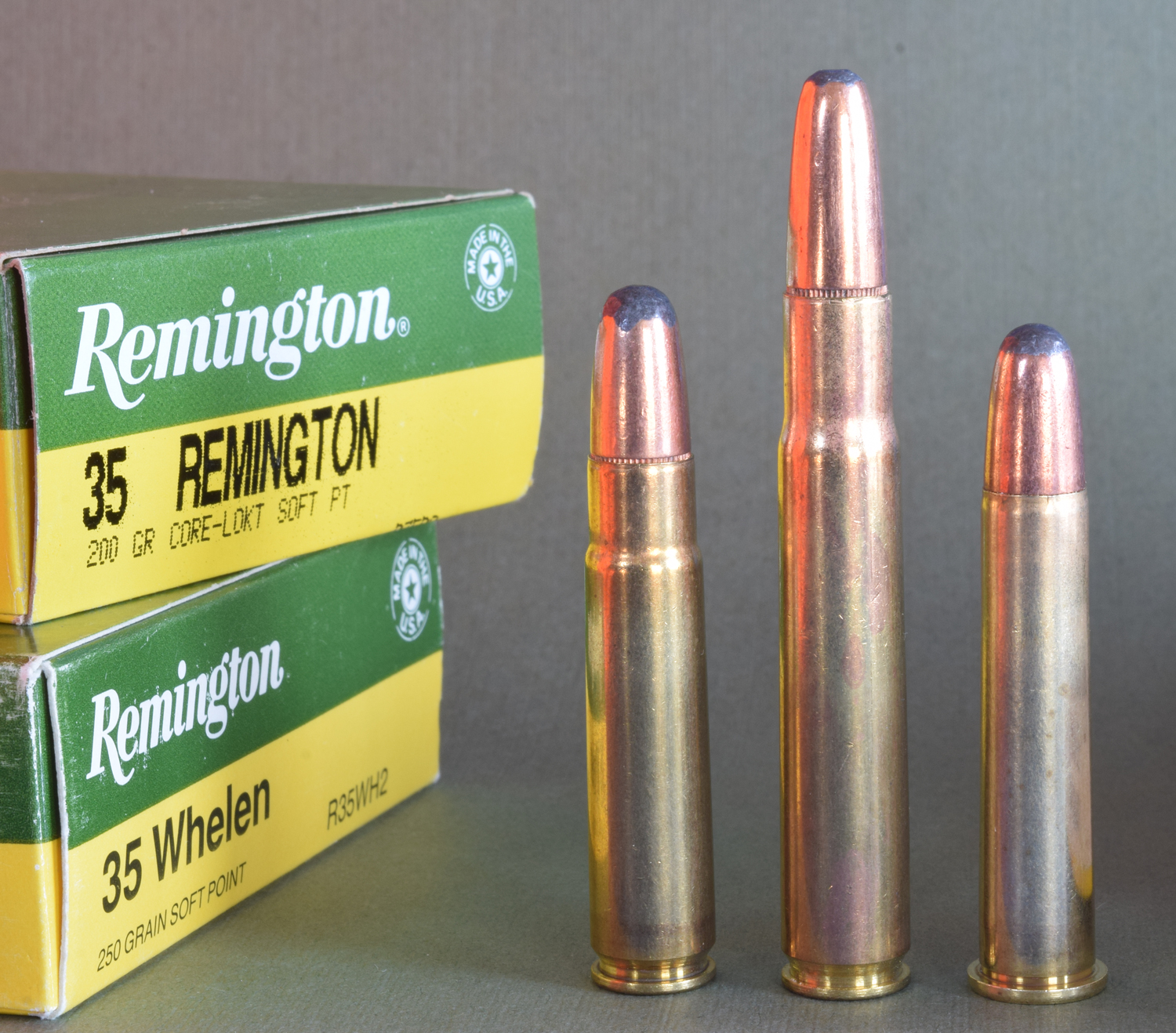
The 35 Whelen, developed with James V. Howe, dwarfs the 35 Remington (left), 360 Rem. Buckmaster (right).
During WW I, Whelen served on the Army’s General Staff. Then he transferred out of Infantry to Ordnance. There Army resources fueled his experiments with rifles, loads and optical sights. Wildcatting cartridges—re-shaping cases to form others—he gave the 30-06 hull new faces. As early as 1919 he was working on a 38 Whelen with Michigan gunsmith Adolph O. Niedner, using 275-grain 38-72 bullets re-configured with a pointed nose. In a letter that August to New York gunsmith Fred Adolph on this effort, Whelen wrote: “It is a pretty expensive job getting a new [Winchester] nickel steel barrel…at the price they now ask ($20.), and then having it rebored for $18.” When in 1923 Winchester dropped the 38-72 from its ammunition list, the 38 Whelen project withered. It would be revived in the 1950s. The resulting 375 Whelen has much in common with the 9.3×62 (.366-inch diameter), a German round dating to 1905.
The 25 Whelen is essentially a 25-06, most often credited to Neidner. Remington began loading it in 1969. Whelen’s .400 suffered from a dearth of .411-inch bullets. It is also out of step with the current trend to slender rocket-shaped bullets for shots spanning zip codes. Still, it’s an efficient round and, with 300-grain bullets at 2,250 fps, adequate for any beast. While reformed 30-06 cases have enough shoulder to headspace, the original shoulder diameter was .458-inch, not .441, per the 30-06. Thus, chambers for the .400 are best measured to ensure they match loading dies. Yes, the 400 Whelen does kick—as my similar 411 Hawk attests.
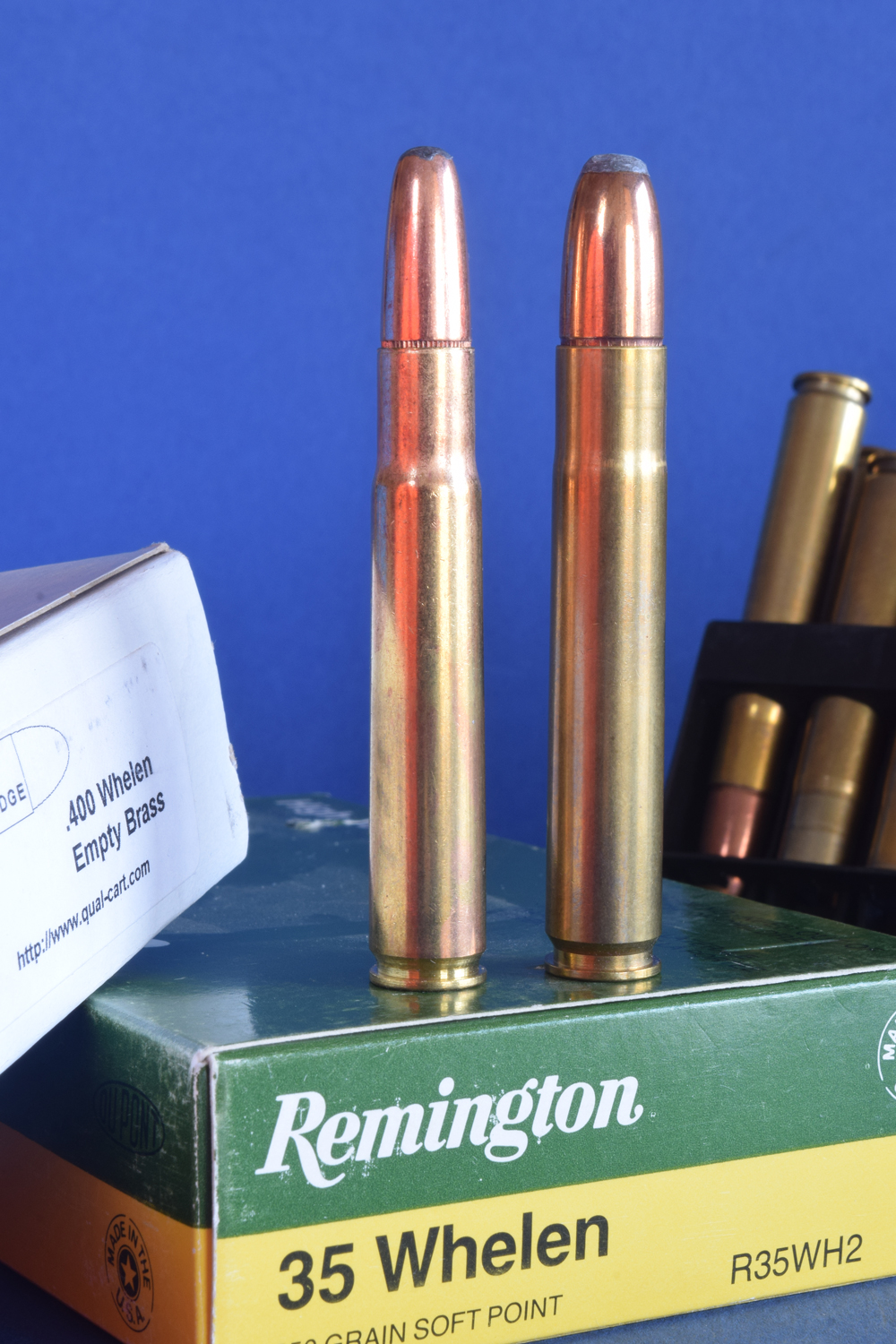
The 35 Whelen (left) was adopted by Remington in 1987. The potent 400 Whelen remains a wildcat.
The most useful Whelen cartridge is arguably the 35 Whelen. Developed in 1922 with James V. Howe of Griffin & Howe, the .35 Whelen was adopted by Remington in 1987. Its factory loads sent 200- and 250-grain pointed soft-points at 2,675 and 2,400 fps. Hornady now catalogs a 200-grain load at 2,900; it carries a ton of energy 250 yards. Still, the 35 Whelen shines with heavier bullets: 250s and handloaded 275s. It out-performs its parent on tough game, while fitting neatly in a Springfield action. Cases are easily made from 30-06 hulls. The 35 Brown-Whelen, with the ’06 shoulder moved forward, is its ballistic superior but requires more steps in case-forming.
As soon as Remington announced its Model 700 Classic rifle in 35 Whelen, I bought one. With a 4x Redfield scope, it took a moose and a truly big mule deer. Soon thereafter I had a 30-06 Remington Model 78 (a plain, blind-magazine 700) fitted with a 26-inch Douglas barrel in 35 Whelen Improved. Handloads sent 225-grain bullets at 2,750 fps, 250s at just over 2,600. In deep snow in Washington’s Blue Mountains, I came upon a raghorn elk. He collapsed to the shot. Packing him out, I paused to rest in a steep place. On the slope opposite, a stone’s toss away, an eye-popping six-point emerged from a thicket and gawked.
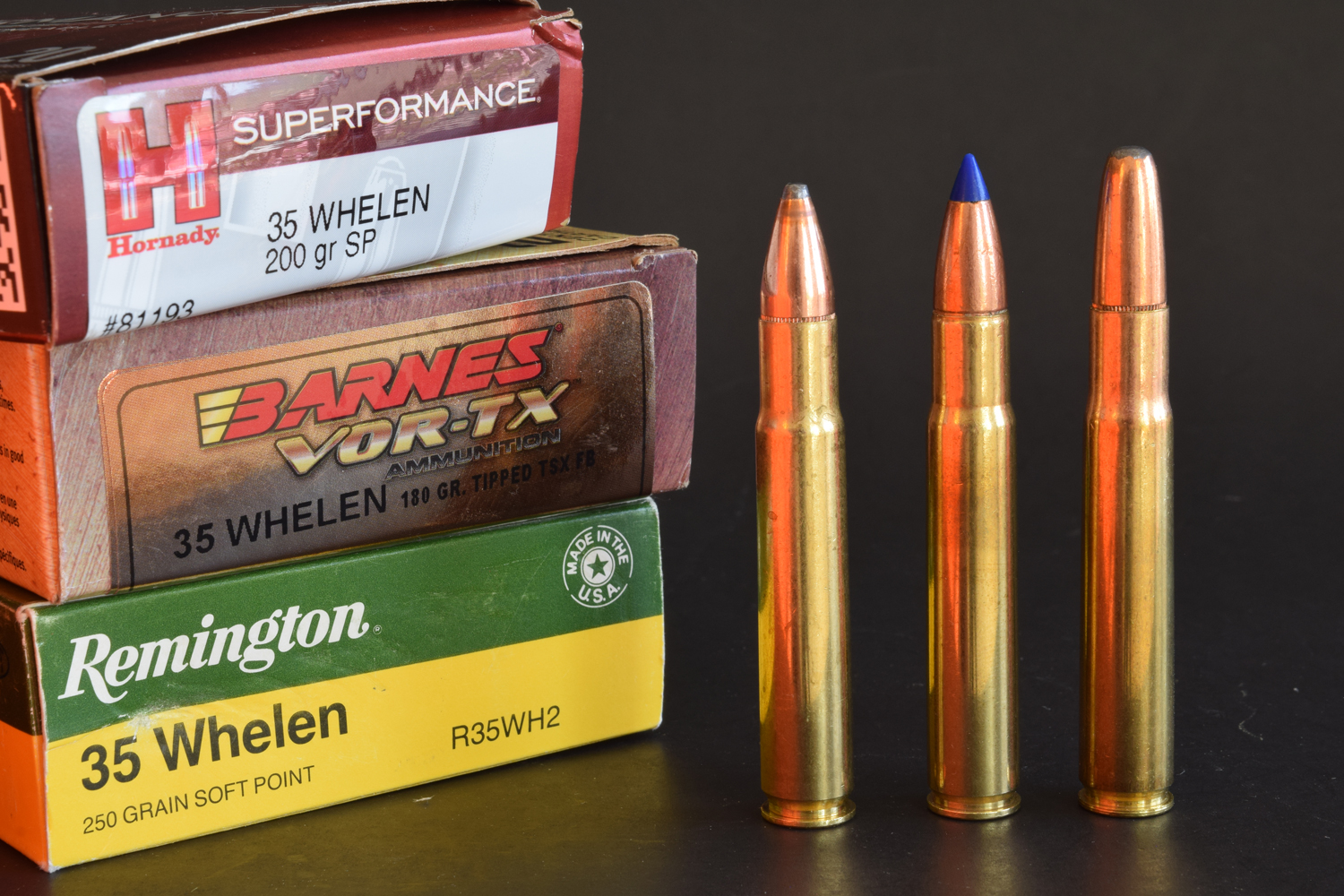
Factory-chambered in a handful of bolt rifles, the 35 Whelen has appeared in Ruger’s No. 1, too.
Townsend Whelen owned a variety of rifles, including single-shots on Sharps-Borchardt, Ballard and Winchester 1885 actions. In the Panama jungle he carried a combination rifle (30-30/20-gauge) built for him by Fred Adolph. He used Savage and Winchester lever-actions.
But of 32 firearms comprising his “battery” (listed by E.R. Jackson in Whelen’s autobiography, Mister Rifleman), 24 are bolt rifles. The one shotgun is a 16-gauge Sauer double he bought for $100 in 1950 from a soldier returning from Germany. Five single-shot rifles have dropping-block actions. While several bolt rifles wear thick barrels, three are “match” models built for competition:
The Remington 37 and Winchester 52 are rimfires (two of six .22s on the list); the Shultz & Larsen 54 is a 308 Winchester. Four rifles are on Winchester M70 actions, five on Mausers, seven on 1903 Springfields. Chamberings include several wildcats. The 25-20 and 32-40 date to the 19th century. Later entries range from the 219 Zipper and 22-3000 Lovell to the 35 Whelen. The only lever-action rifle is a Savage 99 in 250-3000.
For most hunts, Whelen favored the cartridge he’d come to adore as a soldier. “I have made quick humane kills on grizzly, moose, elk, caribou, sheep, goat and [deer] with my old 30-06 Springfield.”
Retired from active military service at age 59 in 1936, Whelen dedicated more time to his writing. His first books, Suggestions to Military Riflemen and The American Rifle, had appeared in 1906 and 1918. More books followed: Amateur Gunsmithing (1924), Telescopic Rifle Sights (1936), The Hunting Rifle (1940), Small Arms Design and Ballistics (1945), Why Not Load Your Own? (1957). He wrote hundreds of magazine articles, too, and after corresponding with fabled elephant hunter W.D.M. Bell, contributed the introduction to Bell of Africa. From 1958 to 1961 he authored a column in Guns & Ammo magazine.
Ever an outdoorsman, Whelen last traveled to Canada in 1946. That hunt ended early when he fell crossing a stream and fractured his wrist. He kept in touch with the woods remodeling a 1790 farmhouse on his 200-acre property in Vermont’s Green Mountains. Dubbed “Someday,” it became a haven where he read from a voluminous library. His daughter, Violet Whelen Bowling, said he would take long walks, often tucking his Winchester Model 70 in 257 Roberts under his arm.
Colonel Townsend Whelen died two days before Christmas in 1961, having lived life to the full as soldier, hunter, adventurer, rifleman. His energy, discipline and achievements impressed all who knew him. Accounts of his hunts in wild places ring true with others who’ve taken those trails. He wrote with enthusiasm and insight of what mattered about rifles and hunting, and shared what was best of a time now gone.
I didn’t need another knife. That must have been clear to whomever penned the note tucked with the old Marble’s. As clearly, I had no sheath like the one in the box, hand-tooled with the initials, TW.
This article originally appeared in the 2023 Guns & Hunting issue of Sporting Classics.
Are Only Accurate Rifles Interesting?
In 1957, the March and April issues of American Rifleman carried a two-part article by Townsend Whelen. Its title, “Only Accurate Rifles Are Interesting,” has since been parroted by shooters purporting to share Whelen’s views, and his discriminating eye. Both surfaced early in his writing. “Accuracy is the most important quality in a rifle,” he stated in his book, The American Rifle (The Century Co., New York, 1918). “If the rifle is inaccurate, it is worthless.” A thorough search of his articles might reveal other such declarations—if none more quotable than the
1957 line.
What of that assertion now? Whelen was by all accounts a fine shot, as well as an authority on the arms of his time. Logic still holds that if a bullet misses the mark, the rifle has availed nothing. Accuracy is still the defining measure in Bullseye and Benchrest matches. But what’s taken as acceptable accuracy has changed with the times. It can also turn on application. A rifle to stop big African beasts gets a pass if its bullets punch grapefruit groups at 50 yards. Ditto a historically significant relic with a neglected bore.
“Interesting” is also a broad brush. While utility on the range and afield matters to shooters, many who covet one-hole groups, high scores and big antlers also mind a rifle’s provenance, design and scarcity—even the figure in its wood.
In the corner of my office there’s a tired 03A3 Springfield, its cracked stock repaired with nails. It arrived as a problem child, refusing to eject. It cycles reliably now. The 03A3 interests me because it’s an arm that, with the 30-06 cartridge, helped decide great conflicts. It has served heroes in battle and famous hunters afield. This Springfield has no special provenance, but it shoots as accurately as I can with its iron sights—a rifle just interesting enough to clear the accuracy bar.

